Chapter 17.76
SMALL WIND AND SOLAR ENERGY CONVERSION SYSTEMS
Sections:
17.76.010 What this chapter does.
17.76.050 Small wind energy facility (windmill).
17.76.060 Roof-mounted wind energy system.
17.76.070 Solar energy devices (panels or collectors).
17.76.010 What this chapter does.
This chapter identifies regulations for small wind and solar energy conversion systems in the city. [Ord. O-11-2010 § 2 (Exh. A)].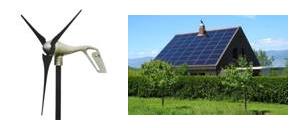
17.76.020 Purpose.
The purpose of this chapter is to provide regulations for the safe and effective construction and operation of small wind and solar energy conversion systems in Eagle Mountain City, subject to reasonable restrictions, which are designed to protect and preserve the general health, safety and welfare of the public. [Ord. O-11-2010 § 2 (Exh. A)].
17.76.030 Findings.
Eagle Mountain City finds the following:
A. That wind and solar energy are abundant, renewable, and nonpolluting energy resources;
B. The conversion of wind and solar energy to electricity will reduce individual dependence on nonrenewable energy resources and decrease the air and water pollution that results from the use of conventional energy sources;
C. That wind energy systems and solar energy devices may eventually enhance the reliability and power quality of the power grid, reduce peak power demands, and help diversify energy supply;
D. The existence of small wind energy systems and solar energy devices in the city provides a positive image for the city, promoting the use of clean renewable energy sources;
E. The unnecessary proliferation of wind energy facilities and solar energy devices throughout the city creates a potentially negative visual impact (visual pollution) on the community, especially in neighborhoods with smaller lots;
F. The visual effects of wind energy facilities and solar energy devices can be mitigated by fair standards regulating their siting, construction, maintenance, and use. [Ord. O-11-2010 § 2 (Exh. A)].
17.76.040 Definitions.
“Small wind energy system” means a wind energy conversion system consisting of a wind turbine, a tower, and associated control or conversion electronics, which has a rated capacity of not more than 100 kilowatts (kW) and which is intended to primarily reduce on-site consumption of utility power.
“Solar energy device” means an accessory structure that is roof-mounted or wall-mounted, the primary purpose of which is to provide for the collection, inversion, storage, and distribution of solar energy for electricity generation, space heating, space cooling, or water heating of buildings located on the same property.
“Total extended height” means the height above grade to a blade tip at its highest point of travel.
“Tower height” means the height above grade of the fixed portion of the tower, excluding the wind turbine. [Ord. O-11-2010 § 2 (Exh. A)].
17.76.050 Small wind energy facility (windmill).
A. Allowed Areas. A standalone small wind energy facility may be installed in any zoning district, subject to the requirements in this section. Small wind energy systems requesting minor modifications to the performance standards of this section may be reviewed by conditional use permit.
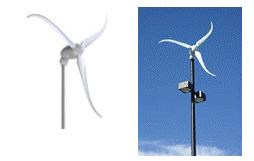
B. Use and Design Standards. All small wind energy systems shall comply with the following standards.
1. Setbacks. The base of the tower shall be set back a distance no less than 50 percent of the total extended height from a property line, and 110 percent of the total extended height from all overhead utility lines, dwellings, accessory structures with living space (accessory dwelling units), and public roads. All small wind energy systems shall be located completely within the rear yard; they shall not be located in any front or side yard.
2. Height. The total extended height of the system shall adhere to the following standards:
a. Forty-five feet or less on parcels of one-half acre to five acres.
b. Sixty-five feet or less on parcels of five or more acres.
3. Sound. Sound produced by the turbine under normal operating conditions, as measured at the property line, shall not exceed the definition of nuisance noise (65 decibels). Sound levels, however, may be exceeded during short-term events out of human control, such as utility outages and/or severe wind storms.
4. Clearance. Ground clearance of rotor blades shall be a minimum of 25 feet.
5. Access. Towers shall be constructed to provide one of the following means of access control, or other appropriate method of access:
a. Tower-climbing apparatus located no closer than 12 feet from the ground.
b. A locked anti-climb device installed on the tower.
c. A locked, protective fence at least six feet in height that encloses the tower.
6. Guy Wires. Anchor points for any guy wires for a tower shall be located within the property that the system is located on and not on or across any aboveground electric transmission or distribution lines, and may not be located in the front yard. The point of attachment for the guy wires shall be enclosed by a fence six feet high or sheathed in bright orange or yellow covering from three to eight feet above the ground.
7. Shut-Off Mechanism. The facility shall be designed with an automatic shut-off mechanism, so that in the event of a power outage, the facility will not back-feed into the power grid.
8. Code Compliance. All small wind energy systems shall be designed and constructed to be in compliance with pertinent provisions of the International Building Code, National Electric Code, and any other applicable codes.
9. Over-Speed Control. All small wind energy systems shall be equipped with manual and automatic over-speed controls. The conformance of rotor and over-speed control design and fabrication with good engineering practices shall be certified by the manufacturer.
10. Lighting. Exterior lighting on any structure associated with the facility shall not be allowed except that which is specifically required by the Federal Aviation Administration.
11. All signs, other than the manufacturer’s or installer’s identification, appropriate warning signs, or owner identification, on a wind generator, tower, building, or other structure associated with a small wind energy system visible from any public road shall be prohibited. At least one sign shall be posted on the tower at a height of five feet warning of electrical shock or high voltage and harm from revolving machinery.
12. All on-site electrical wires associated with the facility shall be installed underground.
13. Color. The facility’s tower and blades shall be painted or treated a nonreflective, unobtrusive color that blends the facility and its components into the surrounding landscape and incorporate nonreflective surfaces to minimize any visual disruption. In general, the factory default gray color is appropriate.
14. Subdivision Covenants, Conditions, and Restrictions (CC&Rs). Some CC&Rs may contain restrictions on small wind energy facilities. The more restrictive of the city code and the subdivision CC&Rs shall apply.
C. Maintenance. All small wind energy facilities shall be maintained in good condition and in accordance with all requirements of this section.
D. Inspections Required. All small wind energy systems require a building permit. No facility shall be connected to the power grid until Eagle Mountain City power department has inspected and approved the system.
E. Net Metering. The owner of the facility must sign a net metering agreement with Eagle Mountain City power department prior to connecting to the power grid.
F. Building Permit Application. The applicant shall submit a building permit application to the city building department. As part of the submittal and in addition to the application requirements, the applicant shall be required to submit the following items:
1. Evidence that the proposed tower height does not exceed the height recommended by the manufacturer or distributor of the system.
2. Standard drawings of the wind turbine structure and stamped engineered drawings of the tower, base, footings, and/or foundation as provided by the manufacturer. Wet stamps shall not be required.
3. A line drawing of the electrical components, as supplied by the manufacturer, in sufficient detail to allow for a determination that the manner of installation conforms to the National Electrical Code.
4. A site plan (drawn to scale) showing the location of the small wind energy facility in relation to other structures or above-ground power lines on the site and on adjacent neighboring properties.
G. Approval. Approval shall be given based upon compliance with the standards of this section and requirements of the city building department, the International Building Code, the National Electrical Code, and approval by the planning director (or designee) and energy department director (or designee). [Ord. O-11-2010 § 2 (Exh. A)].
17.76.060 Roof-mounted wind energy system.
A. Allowed Areas. Roof-mounted wind energy facilities are permitted as an accessory use in all zoning districts, subject to the standards in this section. Minor modifications to the performance standards of this section may be reviewed by conditional use permit.
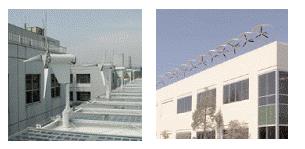
B. Use and Design Standards. All roof-mounted wind energy facilities shall comply with the following standards:
1. Height. Wind energy systems may not project more than five feet above the roofline of the building. Higher-projecting systems must be reviewed as a conditional use permit.
2. Design. The system shall be integrated into the design of the building as much as possible, and not viewed as an obvious afterthought.
3. Sound. Sound produced by the windmill under normal operating conditions, as measured at the property line, shall not exceed the definition of nuisance noise (65 decibels). Sound levels, however, may be exceeded during short-term events out of human control, such as utility outages and/or severe wind storms.
4. The windmill shall be painted or treated a nonreflective, unobtrusive color that blends the facility and its components into the surrounding landscape and rooftop and incorporate nonreflective surfaces to minimize any visual disruption. In general, the factory default gray color is appropriate.
5. Shut-Off Mechanism. The system shall be designed with an automatic shut-off mechanism, so that in the event of a power outage, the facility will not back-feed into the power grid.
6. Code Compliance. All wind energy systems shall be designed and constructed to be in compliance with pertinent provisions of the International Building Code, National Electric Code, and any other applicable codes.
7. Over-Speed Control. All wind energy systems shall be equipped with manual and automatic over-speed controls. The conformance of rotor and over-speed control design and fabrication with good engineering practices shall be certified by the manufacturer.
8. Subdivision Covenants, Conditions, and Restrictions (CC&Rs). Some CC&Rs may contain restrictions on rooftop wind energy facilities. The more restrictive of the city code and the subdivision CC&Rs shall apply.
C. Maintenance. All wind energy facilities shall be maintained in good condition and in accordance with all requirements of this section.
D. Inspections Required. All wind energy systems require a building permit. No facility shall be connected to the power grid until the Eagle Mountain City power department or other utility providing electric service has inspected and approved the system.
E. Net Metering. The owner of the system must sign a net metering agreement with Eagle Mountain City prior to connecting to the power grid.
F. Building Permit Application. The applicant shall submit a building permit application to the city building department. As part of the submittal and in addition to the application requirements, the applicant shall be required to submit the following items:
1. Elevations/renderings of the building showing the wind energy system.
2. A line drawing of the electrical components, as supplied by the manufacturer, in sufficient detail to allow for a determination that the manner of installation conforms to the National Electrical Code.
G. Approval. Approval shall be given based upon compliance with the standards of this section and requirements of the city building department, the International Building Code, the National Electrical Code, planning director (or designee) and energy department director (or designee). [Ord. O-11-2010 § 2 (Exh. A)].
17.76.070 Solar energy devices (panels or collectors).
A. Allowed Areas. Solar energy devices may be installed upon the roof of the primary structure or an accessory structure within any zone upon compliance with this section.
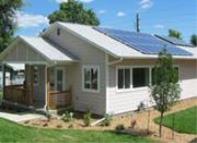
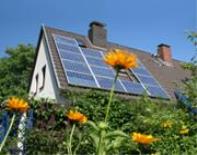
B. Design Standards. All solar energy devices shall comply with the following standards.
1. Collectors shall not extend beyond the lower or upper roofline, or beyond a parapet wall on a flat roof.
2. Collectors on a flat commercial or industrial roof shall be screened so as not to be visible from any public street. Screens shall be aesthetically incorporated into the design of the building and shall conform to the color and materials of the primary building.
3. Collectors on sloped rooftops shall maintain the same angle as the roof, mounted parallel to and flush with the roof slope, and shall not be propped up on one side.
4. Collectors on rooftops shall have a solar skirt/netting installed around the entire panel array per industry standards and maintained in good repair. These must be attached below the panels and above the roof to prevent birds from getting under the panel and nesting and/or roosting.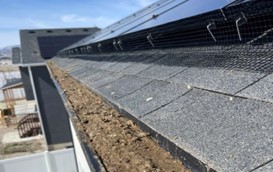
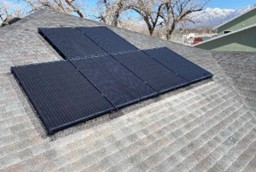
5. Measures shall be taken to minimize sunlight reflection into neighboring windows and rights-of-way. Collectors may be required to be removed if proven to be a safety hazard.
6. The ends of the panel arrays shall be covered and mounting brackets shall blend with the roof.
7. The piping shall blend with the surface to which it is attached.
8. The color of collector frames shall be as compatible as possible with the roof color.
9. Subdivision Covenants, Conditions, and Restrictions (CC&Rs). Some CC&Rs may contain restrictions on solar energy devices. The more restrictive of the city code and the subdivision CC&Rs shall apply.
C. Maintenance. All solar energy devices shall be maintained in good condition and in accordance with all requirements of this section.
D. Building Permit Application. The applicant shall submit a building permit application to the city building department. Additional application requirements apply as per the building department.
E. Inspections Required. All solar energy devices require a building permit and proper inspections by the city building department. No device may be connected to the power grid until the Eagle Mountain City power department or other utility company providing electric service has inspected and approved the system.
F. Net Metering. The owner of the device must sign a net metering agreement with Eagle Mountain City prior to connecting to the power grid. Failure to do so may result in a fine and/or permit revocation.
G. Approval. Approval shall be given by the building department based upon compliance with the standards of this section and requirements of the city building department, the International Building Code, the National Electrical Code, and approval by the planning director (or designee) and energy department director (or designee). [Ord. O-45-2023 § 2 (Exh. A); Ord. O-11-2010 § 2 (Exh. A)].


